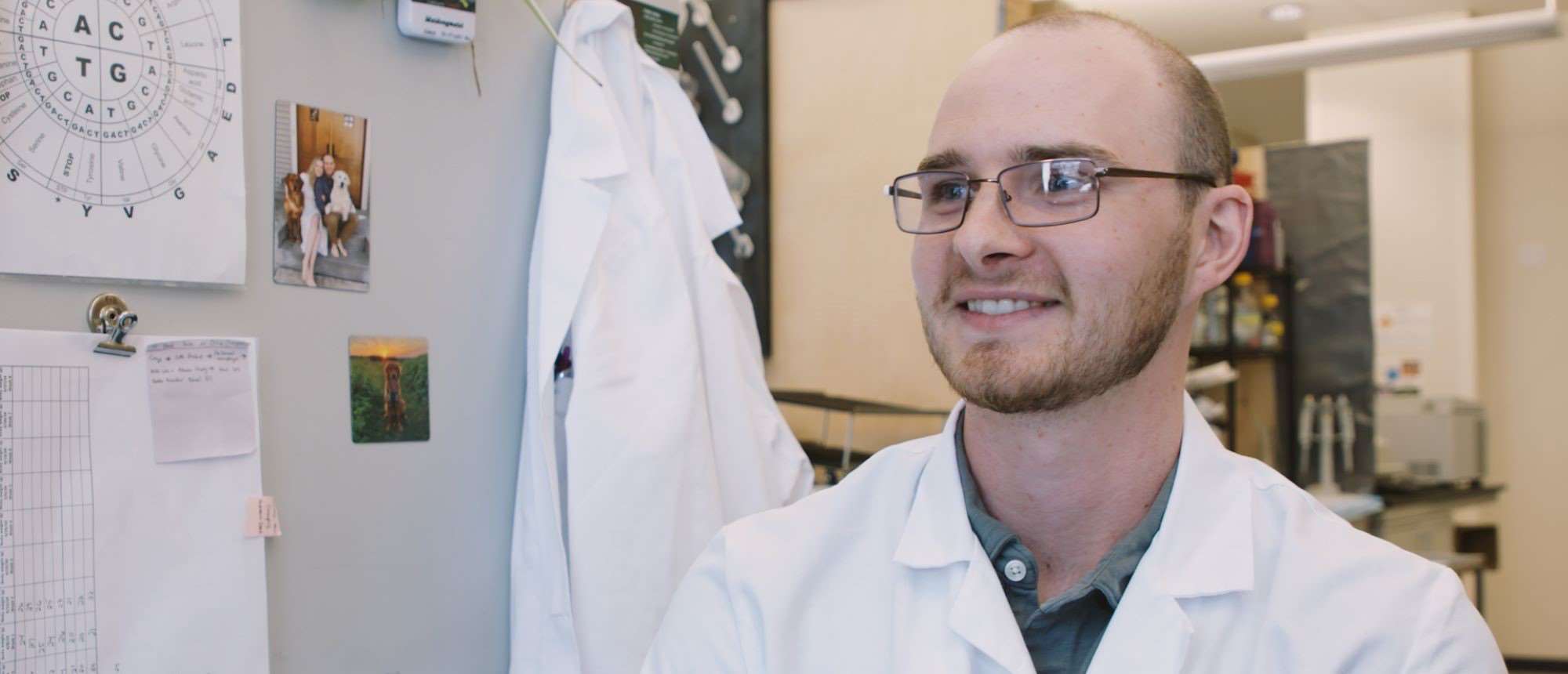Exploring FFAR4, a Receptor in Cardiovascular Disease

Despite decades of progress in treatment, cardiovascular disease remains the leading cause of death globally.
Cholesterol-lowering drugs like statins have improved outcomes for many patients, yet atherosclerosis – a disease characterized by the buildup of plaque in artery walls – continues to be a persistent and deadly condition. This plaque accumulation narrows arteries and can eventually lead to heart attacks or strokes, especially when unstable plaques rupture.
For Gage Stuttgen, PhD’25, a recent graduate from the School of Graduate Studies at the Medical College of Wisconsin (MCW), this complex disease offers a compelling challenge – and a new scientific opportunity.
Over the past five years as a part of the Sahoo Laboratory, he investigated how a G-protein coupled receptor (GPCR) called Free Fatty Acid Receptor 4 (FFAR4) might help regulate plaque formation and stability, potentially offering a new therapeutic pathway in cardiovascular disease treatment.
Connecting Inflammation and Atherosclerosis
FFAR4 is known for its anti-inflammatory signaling and its ability to bind long-chain fatty acids, especially omega-3s. It is expressed in several immune cell types, including macrophages, which play a central role in the development of atherosclerotic plaques.
Stuttgen hypothesized that activating FFAR4 in macrophages might reduce inflammation in arterial walls and limit plaque buildup. His work began by investigating whether FFAR4 affects lipid accumulation in cells, an early step in atherosclerosis. He then expanded to mouse model systems that could measure plaque progression in vivo.
“In general, cardiovascular disease, despite the statins, continues to progress over time,” Stuttgen says. “My project essentially looked at a new protein target that I think is involved in preventing plaque from forming in the arteries.”
Surprising Discovery and a Potential Therapeutic Target
Initial results showed that deleting the FFAR4 gene did increase plaque development, but with a notable twist. The changes were observed in male mice, while female mice showed no significant difference. This finding points toward previously unrecognized sex-specific mechanisms in the function of FFAR4.
As Stuttgen and the team looked deeper, they found that FFAR4’s most important role might not be in plaque quantity, but in plaque quality – specifically, how stable or rupture-prone the plaque becomes over time.
“When you lose this receptor, you actually get an increase in the amount of necrotic core formation,” he says. “These necrotic cores, composed of dead cells and cellular debris, weaken the structural integrity of the plaque. Their presence increases the risk of rupture, which can trigger thrombotic events such as heart attacks and strokes.”
The identification of FFAR4 as a regulator of plaque stability adds a valuable new angle to cardiovascular research. While much of the field has focused on controlling lipid levels in the bloodstream, Stuttgen’s work suggests that stabilizing existing plaques could be just as critical in preventing fatal events.
“We have discovered a new receptor that could play a role in plaque stability and potentially in plaque progression as well,” he says.
These findings also raise new questions about the receptor’s mechanism of action, its interactions with inflammatory signaling pathways, and how these processes differ between sexes. Further studies may explore whether FFAR4 agonists – compounds that stimulate the receptor – could be developed into drugs that help stabilize plaques and reduce cardiovascular risk.
Rooted in a Lab Focused on Lipid Metabolism
Stuttgen’s project aligns with the broader mission of the Sahoo Laboratory, which investigates lipoprotein metabolism, scavenger receptors, and the development of atherosclerosis.
Led by Daisy Sahoo, dean of the School of Graduate Studies and WIS Founders Circle Endowed Professor, the lab explores how cholesterol is transported throughout the body and how imbalances contribute to disease.
The lab examines proteins like LDL (low-density lipoprotein), often labeled “bad cholesterol,” and HDL (high-density lipoprotein), or “good cholesterol,” to better understand the dynamic processes that influence plaque formation and removal.
Stuttgen’s investigation of FFAR4 fits naturally within the lab’s broader interest in cholesterol transport and cardiovascular pathology, while introducing a novel GPCR-mediated anti-inflammatory mechanism into the lab’s atherosclerosis research.
Scientific Growth and the Value of Mentorship at MCW
While Stuttgen’s research stands on its own scientific merit, it also reflects the strength of mentorship and the collaborative culture of the Sahoo Laboratory.
Early in his time at MCW, Stuttgen expressed a strong interest in GPCRs and Dr. Sahoo encouraged him to identify a receptor that could align with the lab’s research mission. That freedom allowed him to shape a project from the ground up.
Throughout his work, Dr. Sahoo gave Stuttgen the guidance – and the independence – needed to grow as a scientist. He was treated as the expert on the project, even as he learned and adapted with each new result.
“Having a mentor like Daisy really taught me how to mentor other people. Watching her as a leader is going to help me in whatever career I choose,” Stuttgen says.
Now, with years of research behind him and promising results ahead, Stuttgen is considering his next steps. Whether in academia, industry, or another path, he carries with him a deep understanding of cardiovascular disease and a commitment to asking – and answering – complex scientific questions.
“The lab is our playground,” he says. “We get to answer questions that nobody has ever tried to answer before.”



